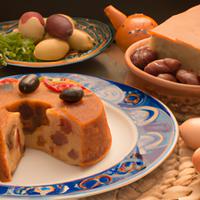
1 serving (100 grams) contains 350 calories, 5.0 grams of protein, 15.0 grams of fat, and 50.0 grams of carbohydrates.

Log this food in SnapCalorie

Nutrition Information
Calories |
833.3 | ||
|---|---|---|---|
% Daily Value* |
|||
| Total Fat | 35.7 g | 45% | |
| Saturated Fat | 19.0 g | 95% | |
| Polyunsaturated Fat | 0 g | ||
| Cholesterol | 119.0 mg | 39% | |
| Sodium | 476.2 mg | 20% | |
| Total Carbohydrates | 119.0 g | 43% | |
| Dietary Fiber | 2.4 g | 8% | |
| Sugars | 71.4 g | ||
| protein | 11.9 g | 23% | |
| Vitamin D | 0 mcg | 0% | |
| Calcium | 47.6 mg | 3% | |
| Iron | 2.4 mg | 13% | |
| Potassium | 238.1 mg | 5% | |
* Percent Daily Values are based on a 2,000 calorie diet. Your daily values may be higher or lower depending on your calorie needs.
Food Attributes
Source of Calories
About Queque seco
Queque Seco is a traditional Peruvian sponge cake known for its light, fluffy texture and simple yet satisfying flavor. Typically made with flour, sugar, eggs, butter, milk, and a touch of vanilla or citrus zest, it offers a mildly sweet taste perfect for pairing with coffee or tea. This dessert is an example of classic Latin American home baking, reflecting a connection to family traditions and gatherings. On the nutritional front, Queque Seco provides carbohydrates for energy and some protein from the eggs, but it is also relatively high in sugar and fat due to the butter and sugar content. While it’s best enjoyed in moderation, versions with whole wheat flour or reduced sugar can make it a slightly healthier indulgence. Perfect as a midday treat or a festive addition to celebrations, Queque Seco remains a beloved staple of Peruvian cuisine.



